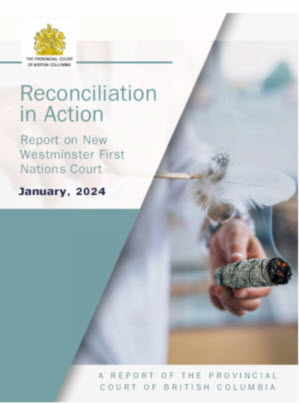An Indigenous man in his mid-fifties with a brain injury and a serious substance abuse history first appeared in New Westminster First Nations Court in April, 2021 on a break and enter charge. He was homeless and used heroin every day. His grandparents had attended residential schools. His mother had been adopted. During his time with the First Nations Court, he was able to maintain sobriety and housing, reconnect with his children and their mother, and limit his drug use to prescribed methadone.
This is one of 20 stories told in more detail in Reconciliation in Action, a new BC Provincial Court report on its New Westminster First Nations Court (NWFNC). Each story outlines a client’s background, the resources offered by the court, the impact of working with the court’s Elders, and the client’s progress on their healing plan. Although about 70 clients are currently participating in NWFNC, the report focuses on 20 who have been involved long enough to take advantage of the supports the court offers.

To provide context for the stories, the report begins with an overview of how the BC Provincial Court’s Indigenous courts work using a holistic, Indigenous-based approach to sentencing, and explains the role of NWFNC participants including Elders, the Client Liaison Worker, and service providers.
Chief Judge Melissa Gillespie said, “We decided to focus on clients’ experience rather than just data in this report in order to tell clients’ stories, including the effects of inter-generational trauma, and permit a more comprehensive assessment of NWFNC’s impact on them.”
The detailed information the report provides about each client shows that NWFNC improved clients’ overall wellness in addition to addressing specific factors that led to their offending.
Improving lives
Sadly, there are many similarities in the histories the report recounts. All NWFNC’s clients have been affected by their parents’ or grandparents’ experiences in the residential school system and “sixties scoop” that separated Indigenous people from their communities, cultures, and languages. Clients witnessed violence and substance use as children and often suffered physical and sexual abuse. Many were in foster care. As adults, most NWFNC clients suffer substance use disorder or mental health issues, or both, and unstable housing is common. Many have children who are in care.
All 20 clients in the report took part in at least one type of counselling while in NWFNC. Some engaged in several types of counselling.
Participating in NWFNC helped many re-establish contact with their children. Some have begun visits and regular involvement in their children’s lives after having had no contact with them at all. One mother was able to have her children returned to her custody.
The Elders also helped clients who were disconnected from their home communities learn about their history, culture, and spirituality.
In addition, clients made significant improvements in housing while participating in NWFNC. The report indicates people who were initially homeless, living in a shelter, or “couch surfing” were able to move to supportive housing, independent living, or living with family as part of their healing plan.
Finally, many of NWFNC’s clients had not committed new offences since they first appeared in the court.
Addressing over-representation of Indigenous people in jail
NWFNC opened in 2006, the first of the BC Provincial Court’s nine Indigenous courts. Although the court is in New Westminster, it accepts charges from around the province. In recent years the court has begun to deal with more serious offences and the number of participants is growing.
The report includes the outcomes of each client’s charges. Community-based sentences are usually imposed in NWFNC, even for more serious offences. The involvement of Elders, healing plans, Indigenous services and wrap-around client supports have proven to be important factors in reducing risk of reoffending. NWFNC clients attend court regularly for reviews, and this increases their supervision and accountability while on bail, probation, or a conditional sentence order.
By supporting clients in community-based sentences and helping them avoid reoffending, NWFNC has reduced the over-representation of Indigenous people in jail.
Reconciliation in action
As Indigenous communities work to restore and rebuild their justice systems, the BC Provincial Court has worked towards reconciliation with them by incorporating aspects of First Nations justice, culture, and practices into its Indigenous sentencing courts. These courts also contribute to reconciliation by helping non-Indigenous people who participate in or watch court sittings gain understanding of Indigenous experience.
Indigenous people have commented on the positive impact NWFNC has on reconciliation, even though it functions within the colonial system. They observe that the court and its Elders create a space where clients learn to trust the court, feel safe in sharing information, and become receptive to accepting help.
Looking ahead
The report concludes that NWFNC has a positive impact on both its clients and public safety and contributes to reconciliation. Looking ahead, the Provincial Court foresees increased demand for court time as the number of clients and seriousness of offences referred to its Indigenous courts continues to increase.
More information
• Reconciliation in Action
• BC’s Indigenous criminal sentencing courts
• What’s the difference between a conditional discharge and a conditional sentence?

